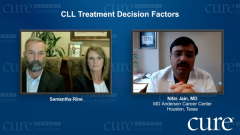
CLL Treatment Decision Factors
Episodes in this series

Nitin Jain, MD: When we diagnosed Samantha with chronic lymphocytic leukemia [CLL], and in general when a patient is diagnosed with CLL, the big question for us is whether you need treatment. Chronic lymphocytic leukemia, or CLL, is one of those diseases where on one hand, the doctor will tell you that you have a leukemia, you have a blood cancer, and in most cases the other thing they will tell you right away is, “We need to watch it; there’s no need for any treatment right now. We just need to observe it.” If you take 100 patients newly diagnosed with CLL, it could be several years, on average maybe five years or so, before they need treatment for their CLL. In early stages of the disease, patients generally have no symptoms; they feel well, their blood cell counts are well, they continue with their normal life. CLL doesn’t affect their quality of life in any fashion, and in that sense, most patients with CLL are generally observed when they are diagnosed.
But when they show some treatment indications, they need treatment. What are the treatment indications? Why would a doctor want to treat a patient with CLL? In my opinion, there are three broad categories. First is if someone has a low hemoglobin count—anemia—generally they will experience shortness of breath. Second is if a patient has low platelet count, they may experience bleeding issues, skin bruising, and things like that. Third is if a patient has big lymph nodes that are causing them to have symptoms, or if they have significant symptoms from their disease that affect their quality of life. If a patient with CLL meets those criteria, then we start treatment.
In Samantha’s case, it just so happens that when she presented on day one, her symptoms were minimal, but her blood cell counts were quite abnormal. They were abnormal to the point that we had to consider starting treatment immediately. When we talk about treatment for patients with CLL, the treatment has evolved quite a bit. Up until a few years ago, we were using chemotherapy-based treatment. I would say in the last five, six years, we’ve started using new drugs that have come along for patients with CLL. Some of them are now FDA-approved for use, such as ibrutinib, acalabrutinib, and venetoclax, which is typically combined with a monoclonal antibody if you are using it for patients with CLL.
Based on the risk profile of Samantha’s CLL, we decided to go with a venetoclax regimen for treatment, which is a pill you take every day, along with a monoclonal antibody treatment, which is generally given once a week for the first month, followed by once a month for about five months. The venetoclax itself is given for a total of one year. So, it’s a regimen that is now FDA approved and is typically given for a one-year duration.
There are some advantages and disadvantages of using this regimen compared to other available regimens, such as ibrutinib and acalabrutinib, where those drugs are supposed to be given forever. You take them as long as they are working for you. There are some other differences as well, which you should certainly discuss with your doctor, but these regimens, using ibrutinib, acalabrutinib, or venetoclax, are effective for a patient with CLL.
Transcript Edited for Clarity















